CIPD HRM Report: HR Professional Development and Team Dynamics
VerifiedAdded on 2023/01/23
|25
|4408
|36
Report
AI Summary
This report offers a comprehensive analysis of Human Resource Management (HRM) within an organizational context, focusing on the Chartered Institute of Personnel and Development (CIPD) professional map. The report explores the CIPD professional map, detailing the knowledge, skills, and behaviors required of HR professionals at various competency levels. It examines two key professional areas: Learning and Talent Development, and Talent and Resource Planning, highlighting the activities and strategies within each. Furthermore, the report delves into the significance of teamwork, exploring group dynamics through Lewin's and Tuckman's theories of group development, as well as Belbin's team roles. The report also addresses conflict resolution methods and the implementation of Project Management, emphasizing the importance of Continuous Professional Development (CPD) and providing a developmental plan for HR professionals.
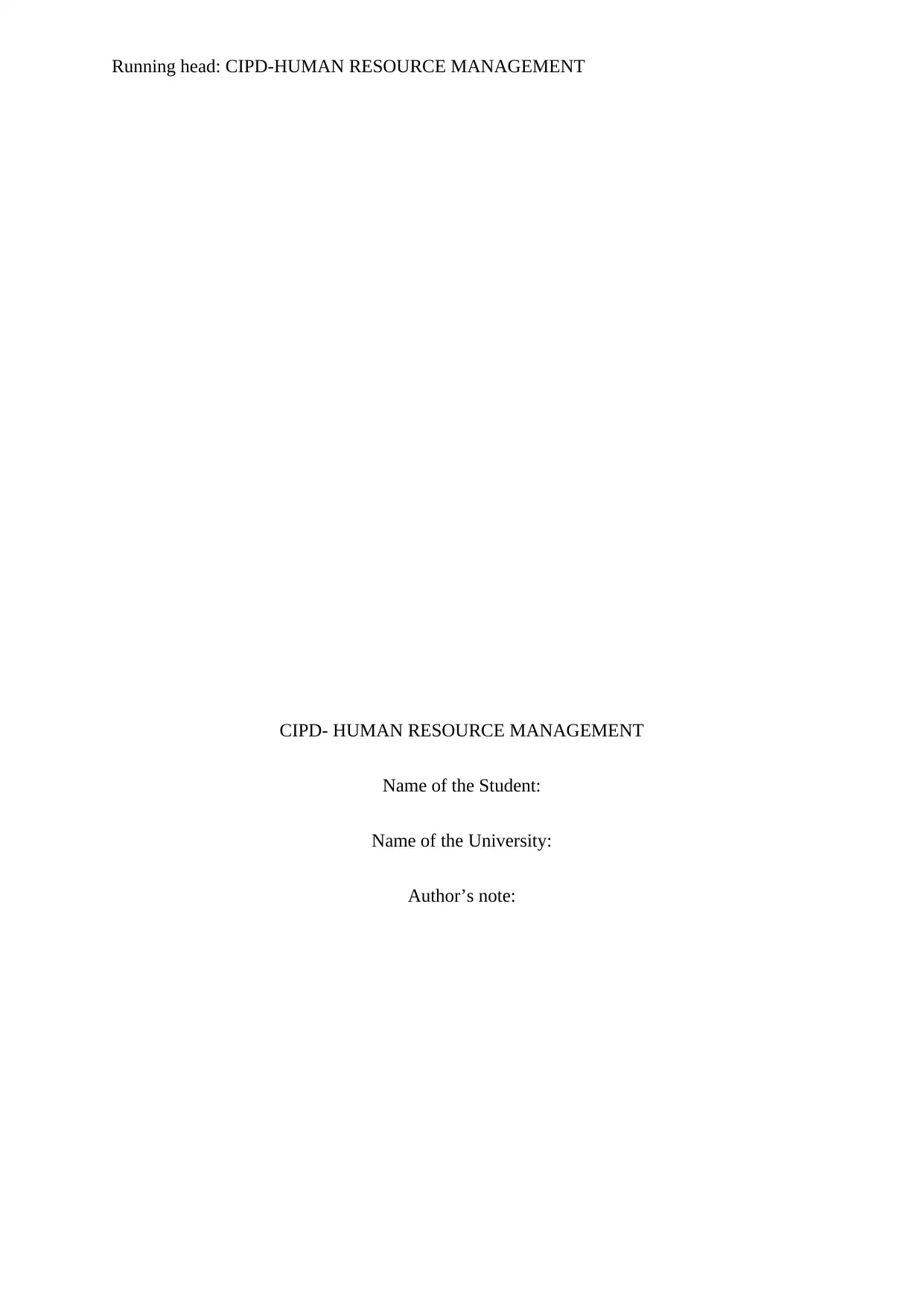
Running head: CIPD-HUMAN RESOURCE MANAGEMENT
CIPD- HUMAN RESOURCE MANAGEMENT
Name of the Student:
Name of the University:
Author’s note:
CIPD- HUMAN RESOURCE MANAGEMENT
Name of the Student:
Name of the University:
Author’s note:
Paraphrase This Document
Need a fresh take? Get an instant paraphrase of this document with our AI Paraphraser
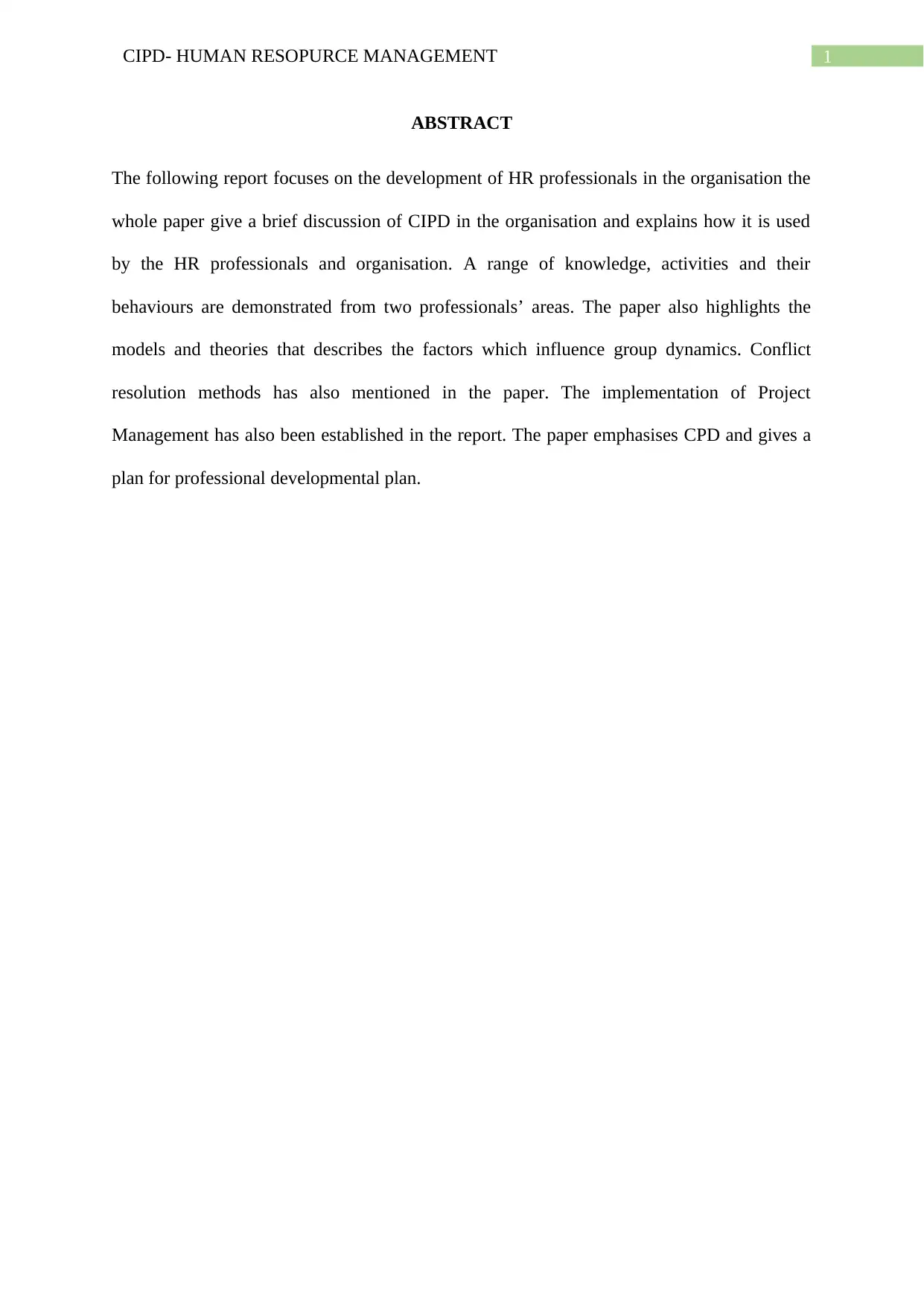
1CIPD- HUMAN RESOPURCE MANAGEMENT
ABSTRACT
The following report focuses on the development of HR professionals in the organisation the
whole paper give a brief discussion of CIPD in the organisation and explains how it is used
by the HR professionals and organisation. A range of knowledge, activities and their
behaviours are demonstrated from two professionals’ areas. The paper also highlights the
models and theories that describes the factors which influence group dynamics. Conflict
resolution methods has also mentioned in the paper. The implementation of Project
Management has also been established in the report. The paper emphasises CPD and gives a
plan for professional developmental plan.
ABSTRACT
The following report focuses on the development of HR professionals in the organisation the
whole paper give a brief discussion of CIPD in the organisation and explains how it is used
by the HR professionals and organisation. A range of knowledge, activities and their
behaviours are demonstrated from two professionals’ areas. The paper also highlights the
models and theories that describes the factors which influence group dynamics. Conflict
resolution methods has also mentioned in the paper. The implementation of Project
Management has also been established in the report. The paper emphasises CPD and gives a
plan for professional developmental plan.
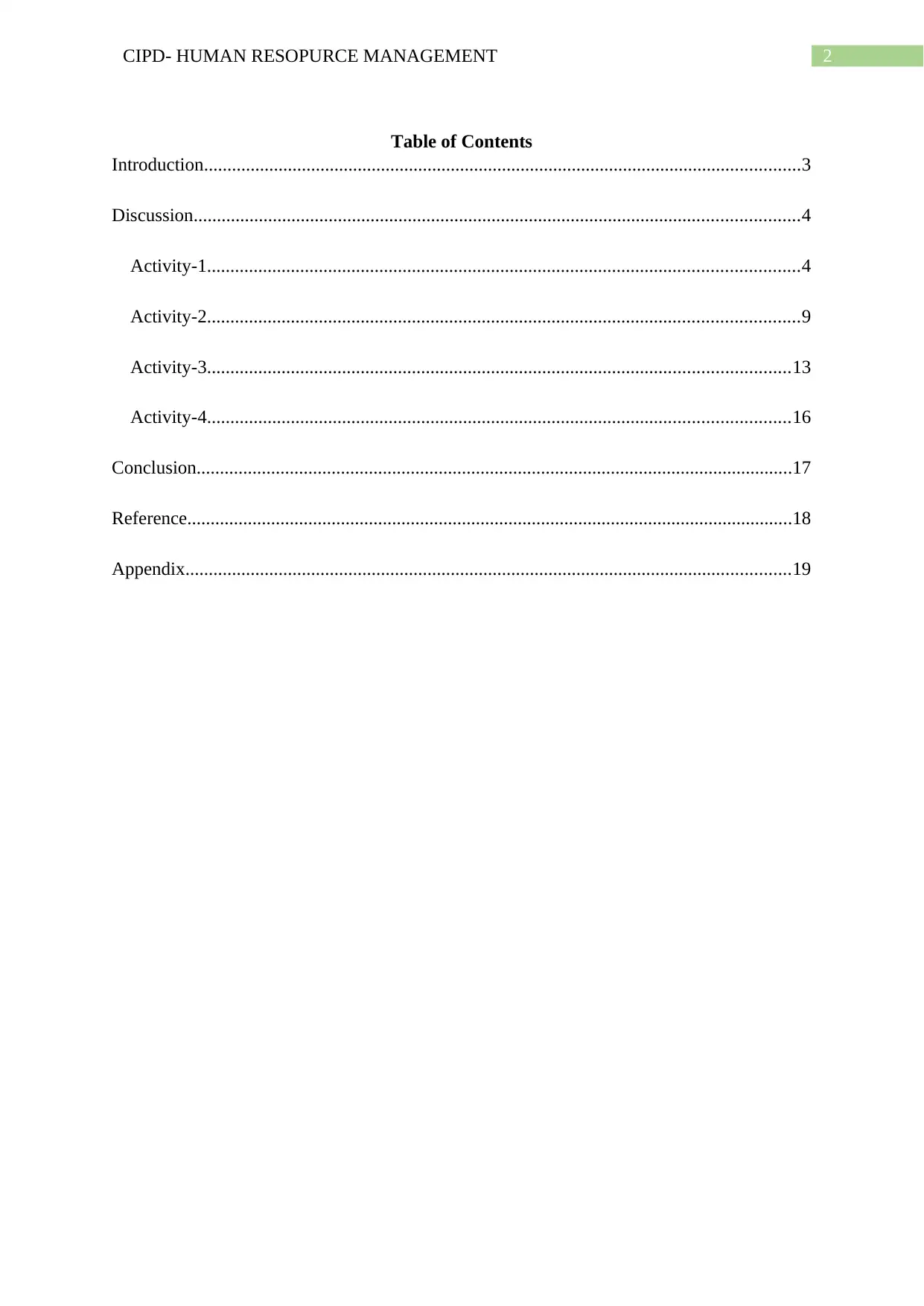
2CIPD- HUMAN RESOPURCE MANAGEMENT
Table of Contents
Introduction................................................................................................................................3
Discussion..................................................................................................................................4
Activity-1...............................................................................................................................4
Activity-2...............................................................................................................................9
Activity-3.............................................................................................................................13
Activity-4.............................................................................................................................16
Conclusion................................................................................................................................17
Reference..................................................................................................................................18
Appendix..................................................................................................................................19
Table of Contents
Introduction................................................................................................................................3
Discussion..................................................................................................................................4
Activity-1...............................................................................................................................4
Activity-2...............................................................................................................................9
Activity-3.............................................................................................................................13
Activity-4.............................................................................................................................16
Conclusion................................................................................................................................17
Reference..................................................................................................................................18
Appendix..................................................................................................................................19
⊘ This is a preview!⊘
Do you want full access?
Subscribe today to unlock all pages.

Trusted by 1+ million students worldwide
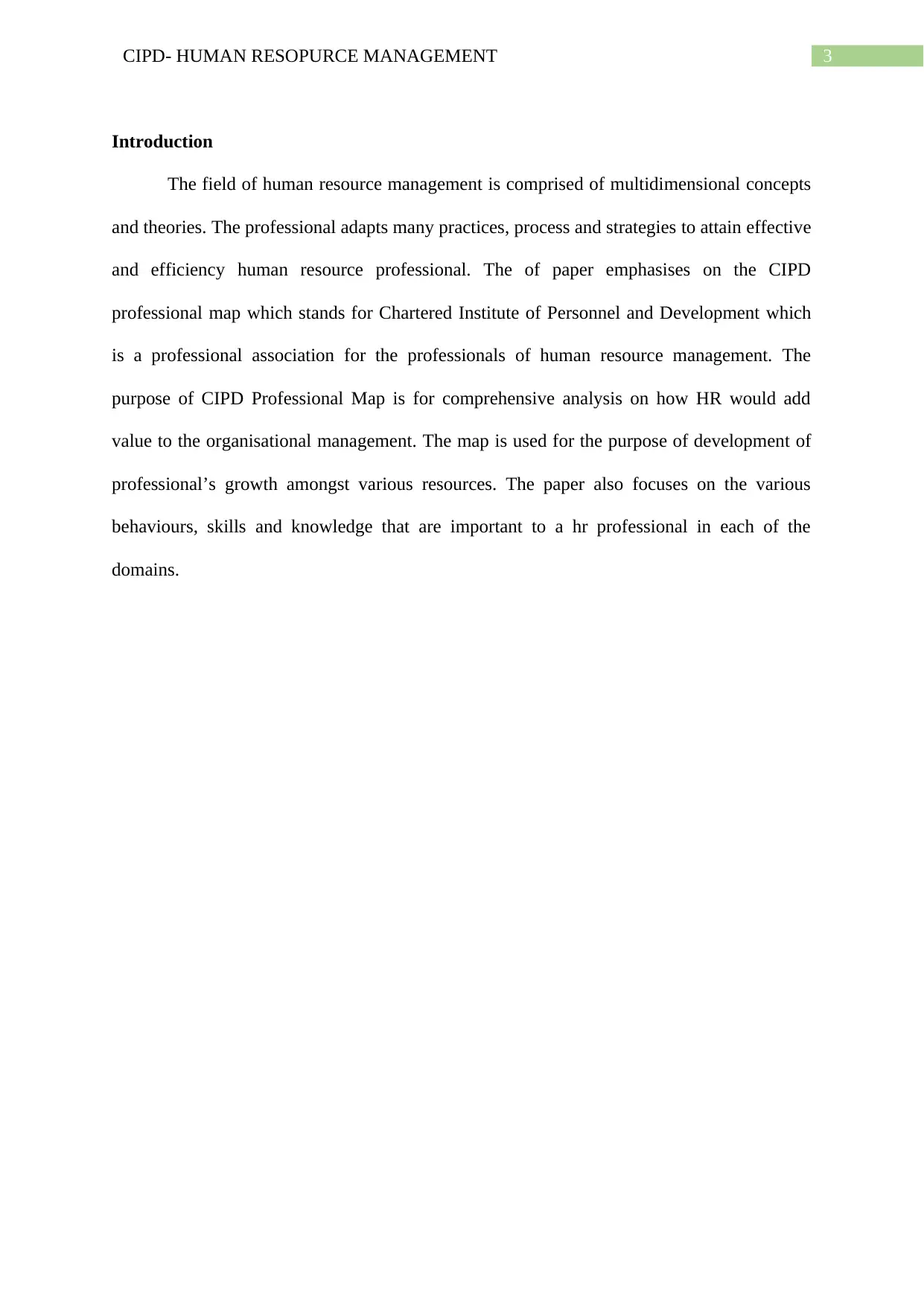
3CIPD- HUMAN RESOPURCE MANAGEMENT
Introduction
The field of human resource management is comprised of multidimensional concepts
and theories. The professional adapts many practices, process and strategies to attain effective
and efficiency human resource professional. The of paper emphasises on the CIPD
professional map which stands for Chartered Institute of Personnel and Development which
is a professional association for the professionals of human resource management. The
purpose of CIPD Professional Map is for comprehensive analysis on how HR would add
value to the organisational management. The map is used for the purpose of development of
professional’s growth amongst various resources. The paper also focuses on the various
behaviours, skills and knowledge that are important to a hr professional in each of the
domains.
Introduction
The field of human resource management is comprised of multidimensional concepts
and theories. The professional adapts many practices, process and strategies to attain effective
and efficiency human resource professional. The of paper emphasises on the CIPD
professional map which stands for Chartered Institute of Personnel and Development which
is a professional association for the professionals of human resource management. The
purpose of CIPD Professional Map is for comprehensive analysis on how HR would add
value to the organisational management. The map is used for the purpose of development of
professional’s growth amongst various resources. The paper also focuses on the various
behaviours, skills and knowledge that are important to a hr professional in each of the
domains.
Paraphrase This Document
Need a fresh take? Get an instant paraphrase of this document with our AI Paraphraser
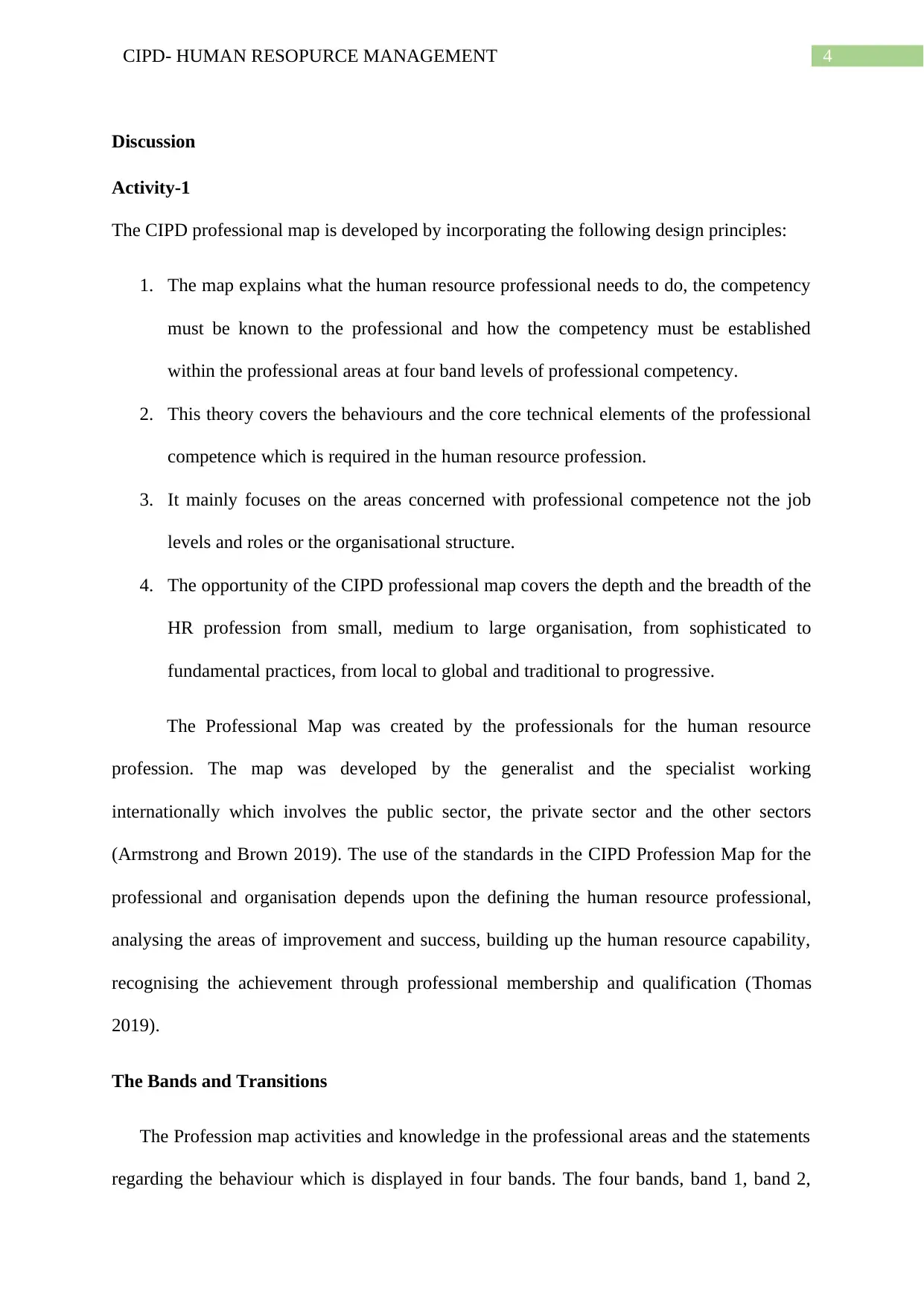
4CIPD- HUMAN RESOPURCE MANAGEMENT
Discussion
Activity-1
The CIPD professional map is developed by incorporating the following design principles:
1. The map explains what the human resource professional needs to do, the competency
must be known to the professional and how the competency must be established
within the professional areas at four band levels of professional competency.
2. This theory covers the behaviours and the core technical elements of the professional
competence which is required in the human resource profession.
3. It mainly focuses on the areas concerned with professional competence not the job
levels and roles or the organisational structure.
4. The opportunity of the CIPD professional map covers the depth and the breadth of the
HR profession from small, medium to large organisation, from sophisticated to
fundamental practices, from local to global and traditional to progressive.
The Professional Map was created by the professionals for the human resource
profession. The map was developed by the generalist and the specialist working
internationally which involves the public sector, the private sector and the other sectors
(Armstrong and Brown 2019). The use of the standards in the CIPD Profession Map for the
professional and organisation depends upon the defining the human resource professional,
analysing the areas of improvement and success, building up the human resource capability,
recognising the achievement through professional membership and qualification (Thomas
2019).
The Bands and Transitions
The Profession map activities and knowledge in the professional areas and the statements
regarding the behaviour which is displayed in four bands. The four bands, band 1, band 2,
Discussion
Activity-1
The CIPD professional map is developed by incorporating the following design principles:
1. The map explains what the human resource professional needs to do, the competency
must be known to the professional and how the competency must be established
within the professional areas at four band levels of professional competency.
2. This theory covers the behaviours and the core technical elements of the professional
competence which is required in the human resource profession.
3. It mainly focuses on the areas concerned with professional competence not the job
levels and roles or the organisational structure.
4. The opportunity of the CIPD professional map covers the depth and the breadth of the
HR profession from small, medium to large organisation, from sophisticated to
fundamental practices, from local to global and traditional to progressive.
The Professional Map was created by the professionals for the human resource
profession. The map was developed by the generalist and the specialist working
internationally which involves the public sector, the private sector and the other sectors
(Armstrong and Brown 2019). The use of the standards in the CIPD Profession Map for the
professional and organisation depends upon the defining the human resource professional,
analysing the areas of improvement and success, building up the human resource capability,
recognising the achievement through professional membership and qualification (Thomas
2019).
The Bands and Transitions
The Profession map activities and knowledge in the professional areas and the statements
regarding the behaviour which is displayed in four bands. The four bands, band 1, band 2,
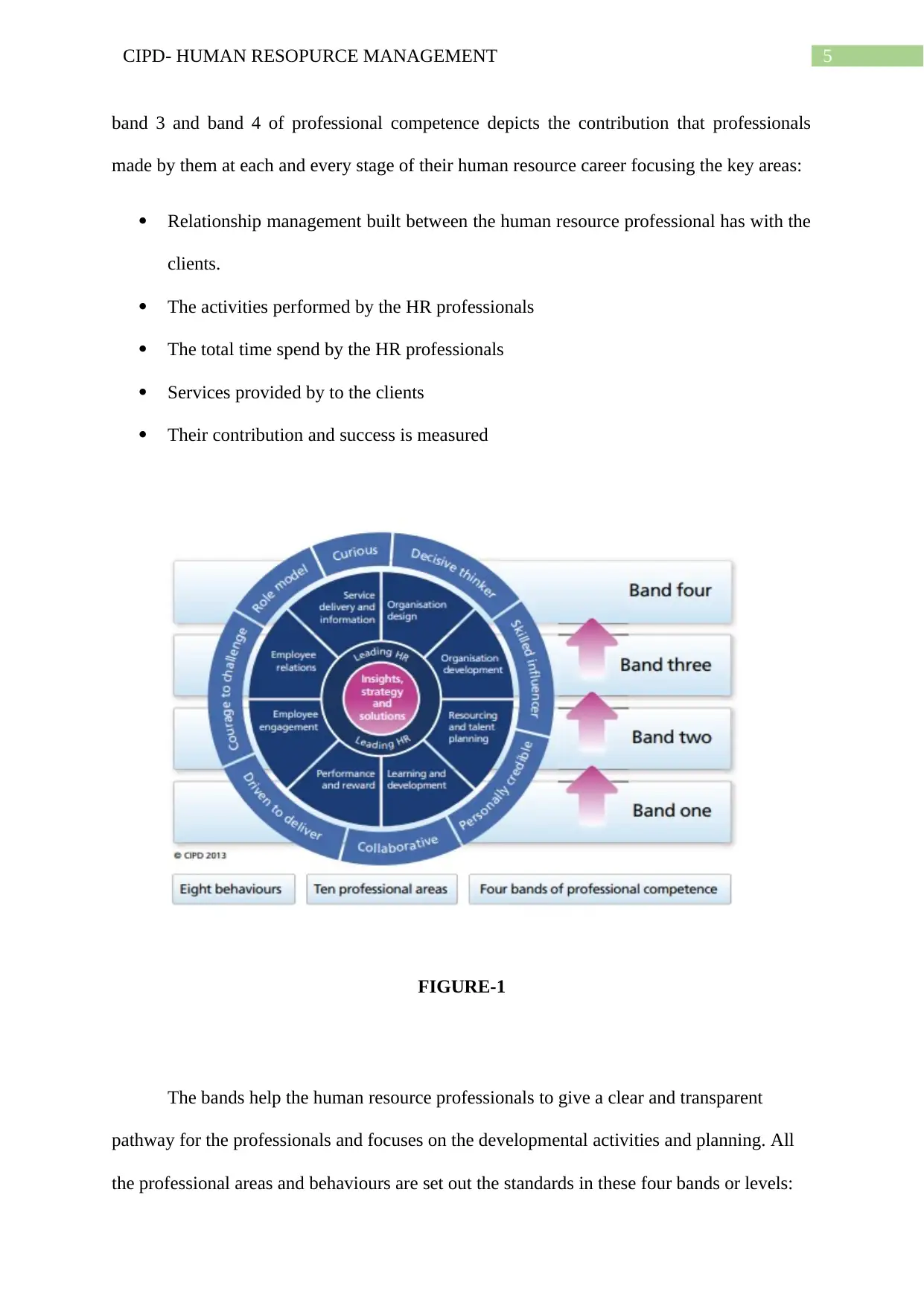
5CIPD- HUMAN RESOPURCE MANAGEMENT
band 3 and band 4 of professional competence depicts the contribution that professionals
made by them at each and every stage of their human resource career focusing the key areas:
Relationship management built between the human resource professional has with the
clients.
The activities performed by the HR professionals
The total time spend by the HR professionals
Services provided by to the clients
Their contribution and success is measured
FIGURE-1
The bands help the human resource professionals to give a clear and transparent
pathway for the professionals and focuses on the developmental activities and planning. All
the professional areas and behaviours are set out the standards in these four bands or levels:
band 3 and band 4 of professional competence depicts the contribution that professionals
made by them at each and every stage of their human resource career focusing the key areas:
Relationship management built between the human resource professional has with the
clients.
The activities performed by the HR professionals
The total time spend by the HR professionals
Services provided by to the clients
Their contribution and success is measured
FIGURE-1
The bands help the human resource professionals to give a clear and transparent
pathway for the professionals and focuses on the developmental activities and planning. All
the professional areas and behaviours are set out the standards in these four bands or levels:
⊘ This is a preview!⊘
Do you want full access?
Subscribe today to unlock all pages.

Trusted by 1+ million students worldwide
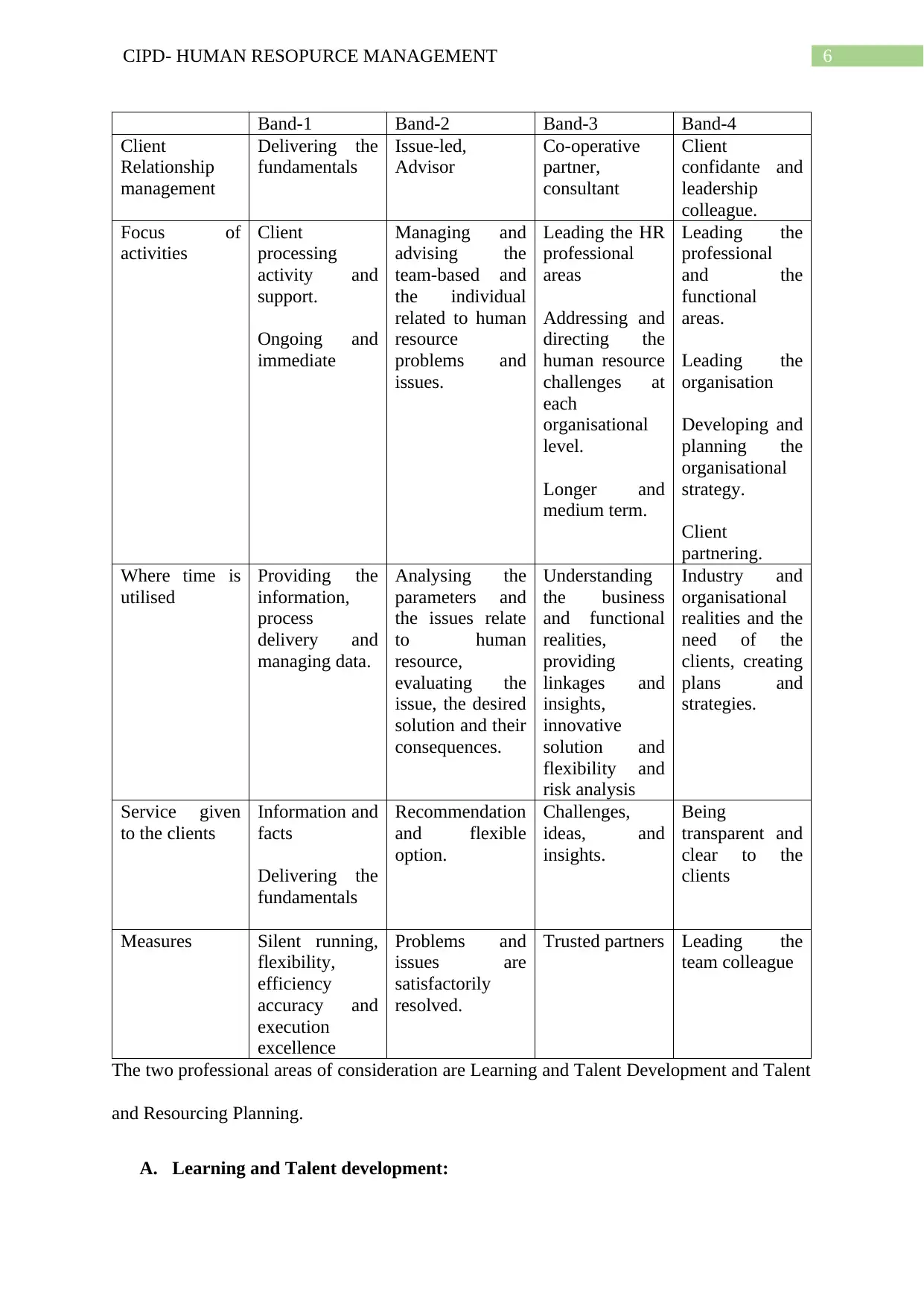
6CIPD- HUMAN RESOPURCE MANAGEMENT
Band-1 Band-2 Band-3 Band-4
Client
Relationship
management
Delivering the
fundamentals
Issue-led,
Advisor
Co-operative
partner,
consultant
Client
confidante and
leadership
colleague.
Focus of
activities
Client
processing
activity and
support.
Ongoing and
immediate
Managing and
advising the
team-based and
the individual
related to human
resource
problems and
issues.
Leading the HR
professional
areas
Addressing and
directing the
human resource
challenges at
each
organisational
level.
Longer and
medium term.
Leading the
professional
and the
functional
areas.
Leading the
organisation
Developing and
planning the
organisational
strategy.
Client
partnering.
Where time is
utilised
Providing the
information,
process
delivery and
managing data.
Analysing the
parameters and
the issues relate
to human
resource,
evaluating the
issue, the desired
solution and their
consequences.
Understanding
the business
and functional
realities,
providing
linkages and
insights,
innovative
solution and
flexibility and
risk analysis
Industry and
organisational
realities and the
need of the
clients, creating
plans and
strategies.
Service given
to the clients
Information and
facts
Delivering the
fundamentals
Recommendation
and flexible
option.
Challenges,
ideas, and
insights.
Being
transparent and
clear to the
clients
Measures Silent running,
flexibility,
efficiency
accuracy and
execution
excellence
Problems and
issues are
satisfactorily
resolved.
Trusted partners Leading the
team colleague
The two professional areas of consideration are Learning and Talent Development and Talent
and Resourcing Planning.
A. Learning and Talent development:
Band-1 Band-2 Band-3 Band-4
Client
Relationship
management
Delivering the
fundamentals
Issue-led,
Advisor
Co-operative
partner,
consultant
Client
confidante and
leadership
colleague.
Focus of
activities
Client
processing
activity and
support.
Ongoing and
immediate
Managing and
advising the
team-based and
the individual
related to human
resource
problems and
issues.
Leading the HR
professional
areas
Addressing and
directing the
human resource
challenges at
each
organisational
level.
Longer and
medium term.
Leading the
professional
and the
functional
areas.
Leading the
organisation
Developing and
planning the
organisational
strategy.
Client
partnering.
Where time is
utilised
Providing the
information,
process
delivery and
managing data.
Analysing the
parameters and
the issues relate
to human
resource,
evaluating the
issue, the desired
solution and their
consequences.
Understanding
the business
and functional
realities,
providing
linkages and
insights,
innovative
solution and
flexibility and
risk analysis
Industry and
organisational
realities and the
need of the
clients, creating
plans and
strategies.
Service given
to the clients
Information and
facts
Delivering the
fundamentals
Recommendation
and flexible
option.
Challenges,
ideas, and
insights.
Being
transparent and
clear to the
clients
Measures Silent running,
flexibility,
efficiency
accuracy and
execution
excellence
Problems and
issues are
satisfactorily
resolved.
Trusted partners Leading the
team colleague
The two professional areas of consideration are Learning and Talent Development and Talent
and Resourcing Planning.
A. Learning and Talent development:
Paraphrase This Document
Need a fresh take? Get an instant paraphrase of this document with our AI Paraphraser
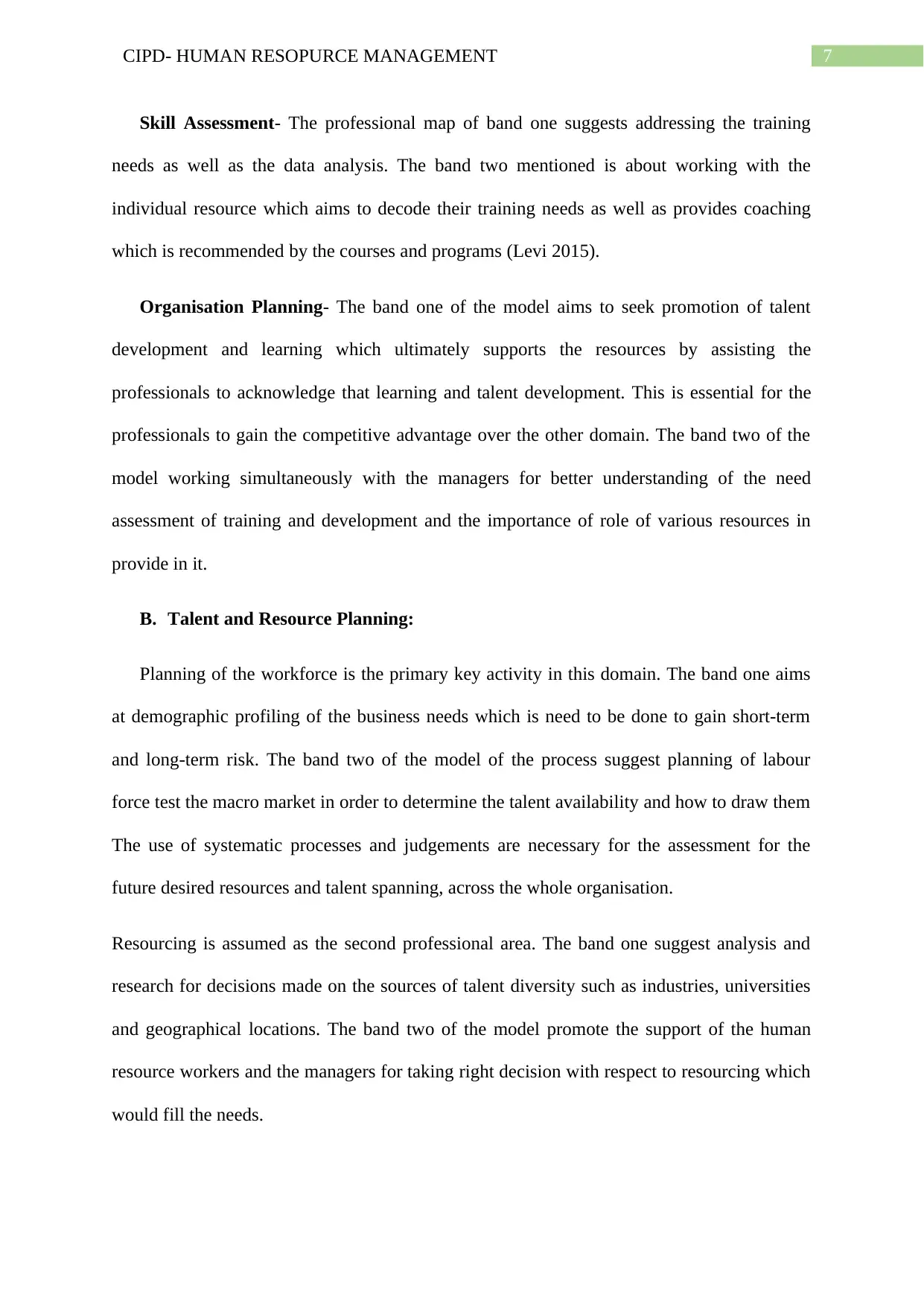
7CIPD- HUMAN RESOPURCE MANAGEMENT
Skill Assessment- The professional map of band one suggests addressing the training
needs as well as the data analysis. The band two mentioned is about working with the
individual resource which aims to decode their training needs as well as provides coaching
which is recommended by the courses and programs (Levi 2015).
Organisation Planning- The band one of the model aims to seek promotion of talent
development and learning which ultimately supports the resources by assisting the
professionals to acknowledge that learning and talent development. This is essential for the
professionals to gain the competitive advantage over the other domain. The band two of the
model working simultaneously with the managers for better understanding of the need
assessment of training and development and the importance of role of various resources in
provide in it.
B. Talent and Resource Planning:
Planning of the workforce is the primary key activity in this domain. The band one aims
at demographic profiling of the business needs which is need to be done to gain short-term
and long-term risk. The band two of the model of the process suggest planning of labour
force test the macro market in order to determine the talent availability and how to draw them
The use of systematic processes and judgements are necessary for the assessment for the
future desired resources and talent spanning, across the whole organisation.
Resourcing is assumed as the second professional area. The band one suggest analysis and
research for decisions made on the sources of talent diversity such as industries, universities
and geographical locations. The band two of the model promote the support of the human
resource workers and the managers for taking right decision with respect to resourcing which
would fill the needs.
Skill Assessment- The professional map of band one suggests addressing the training
needs as well as the data analysis. The band two mentioned is about working with the
individual resource which aims to decode their training needs as well as provides coaching
which is recommended by the courses and programs (Levi 2015).
Organisation Planning- The band one of the model aims to seek promotion of talent
development and learning which ultimately supports the resources by assisting the
professionals to acknowledge that learning and talent development. This is essential for the
professionals to gain the competitive advantage over the other domain. The band two of the
model working simultaneously with the managers for better understanding of the need
assessment of training and development and the importance of role of various resources in
provide in it.
B. Talent and Resource Planning:
Planning of the workforce is the primary key activity in this domain. The band one aims
at demographic profiling of the business needs which is need to be done to gain short-term
and long-term risk. The band two of the model of the process suggest planning of labour
force test the macro market in order to determine the talent availability and how to draw them
The use of systematic processes and judgements are necessary for the assessment for the
future desired resources and talent spanning, across the whole organisation.
Resourcing is assumed as the second professional area. The band one suggest analysis and
research for decisions made on the sources of talent diversity such as industries, universities
and geographical locations. The band two of the model promote the support of the human
resource workers and the managers for taking right decision with respect to resourcing which
would fill the needs.
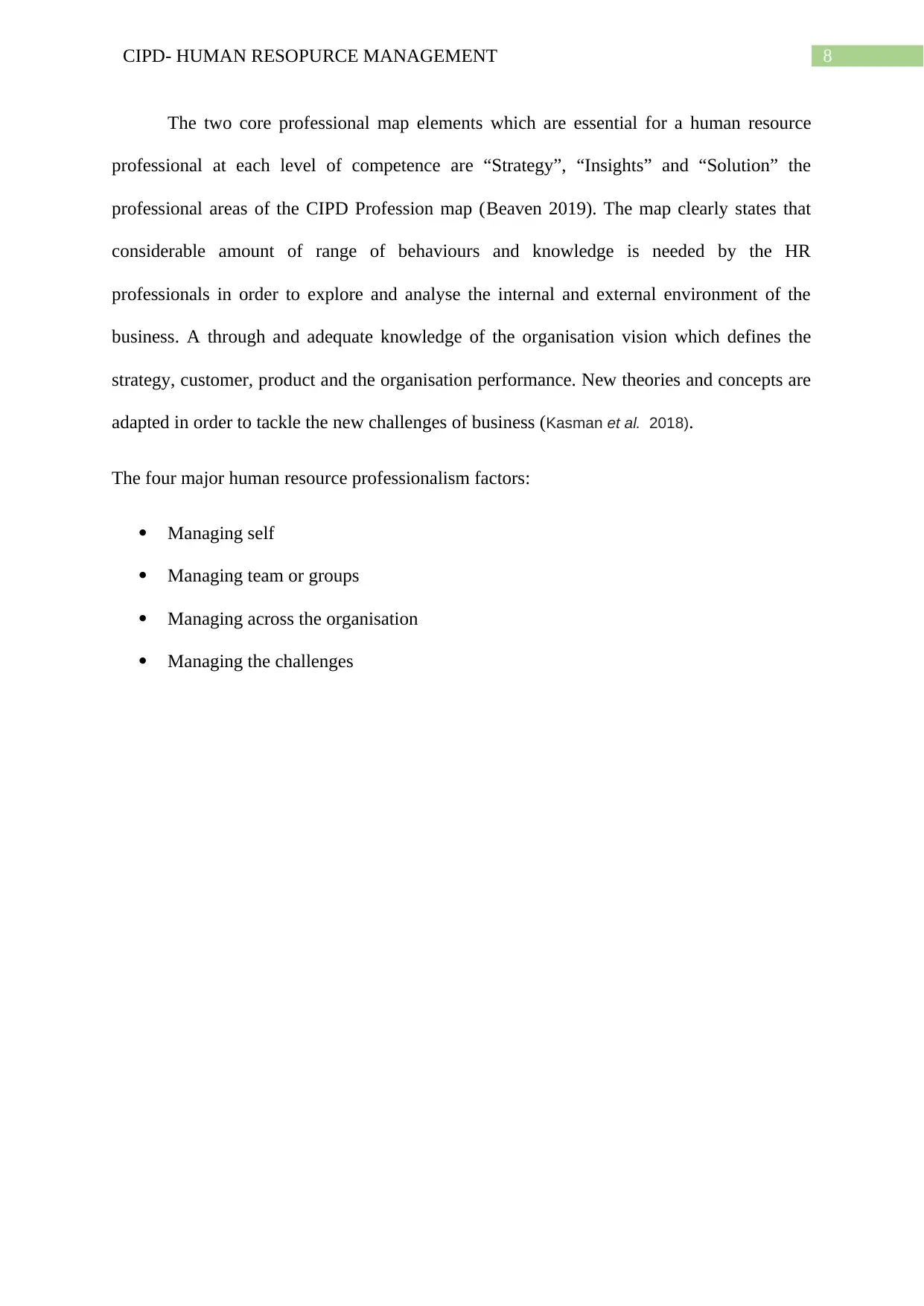
8CIPD- HUMAN RESOPURCE MANAGEMENT
The two core professional map elements which are essential for a human resource
professional at each level of competence are “Strategy”, “Insights” and “Solution” the
professional areas of the CIPD Profession map (Beaven 2019). The map clearly states that
considerable amount of range of behaviours and knowledge is needed by the HR
professionals in order to explore and analyse the internal and external environment of the
business. A through and adequate knowledge of the organisation vision which defines the
strategy, customer, product and the organisation performance. New theories and concepts are
adapted in order to tackle the new challenges of business (Kasman et al. 2018).
The four major human resource professionalism factors:
Managing self
Managing team or groups
Managing across the organisation
Managing the challenges
The two core professional map elements which are essential for a human resource
professional at each level of competence are “Strategy”, “Insights” and “Solution” the
professional areas of the CIPD Profession map (Beaven 2019). The map clearly states that
considerable amount of range of behaviours and knowledge is needed by the HR
professionals in order to explore and analyse the internal and external environment of the
business. A through and adequate knowledge of the organisation vision which defines the
strategy, customer, product and the organisation performance. New theories and concepts are
adapted in order to tackle the new challenges of business (Kasman et al. 2018).
The four major human resource professionalism factors:
Managing self
Managing team or groups
Managing across the organisation
Managing the challenges
⊘ This is a preview!⊘
Do you want full access?
Subscribe today to unlock all pages.

Trusted by 1+ million students worldwide
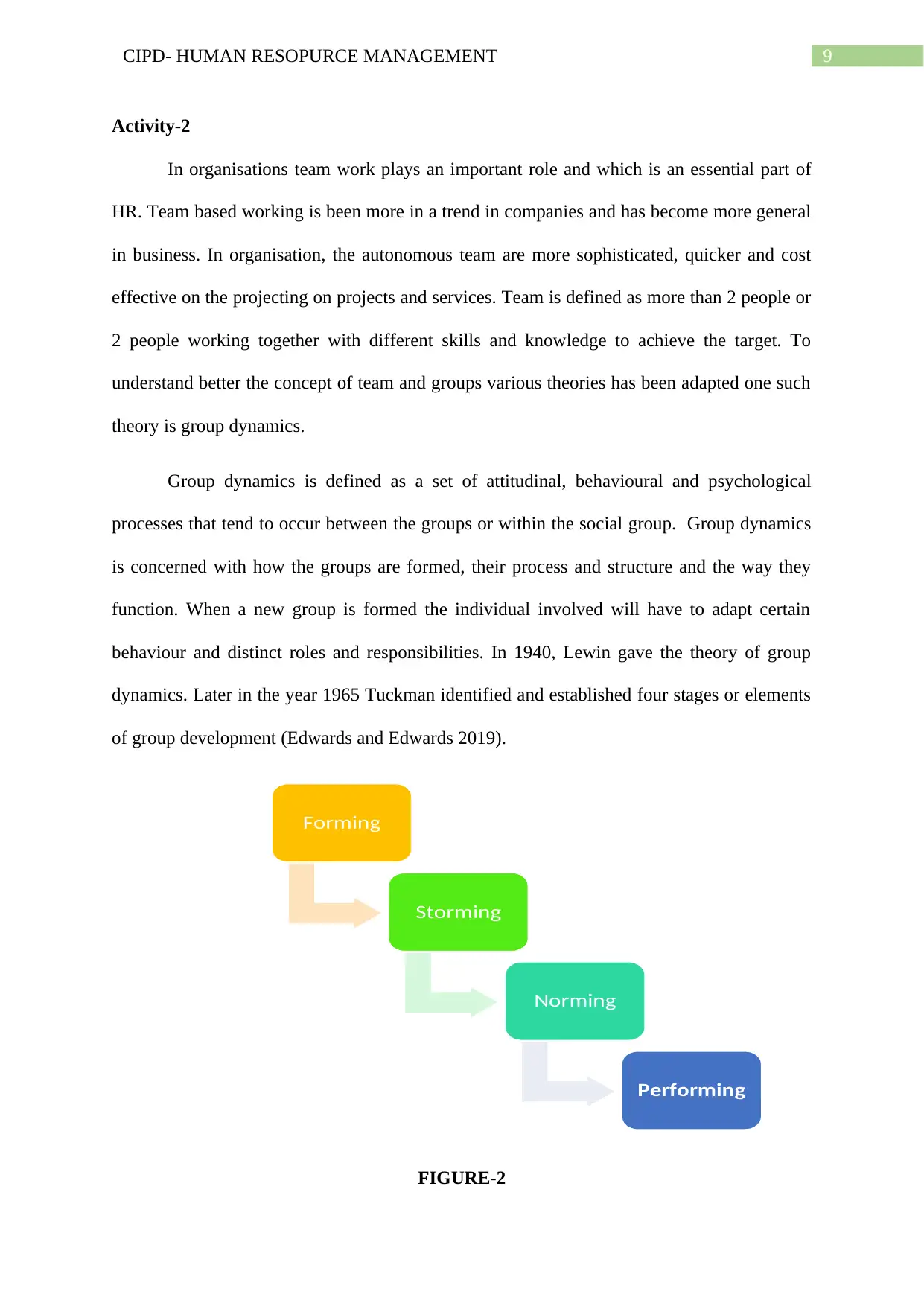
9CIPD- HUMAN RESOPURCE MANAGEMENT
Activity-2
In organisations team work plays an important role and which is an essential part of
HR. Team based working is been more in a trend in companies and has become more general
in business. In organisation, the autonomous team are more sophisticated, quicker and cost
effective on the projecting on projects and services. Team is defined as more than 2 people or
2 people working together with different skills and knowledge to achieve the target. To
understand better the concept of team and groups various theories has been adapted one such
theory is group dynamics.
Group dynamics is defined as a set of attitudinal, behavioural and psychological
processes that tend to occur between the groups or within the social group. Group dynamics
is concerned with how the groups are formed, their process and structure and the way they
function. When a new group is formed the individual involved will have to adapt certain
behaviour and distinct roles and responsibilities. In 1940, Lewin gave the theory of group
dynamics. Later in the year 1965 Tuckman identified and established four stages or elements
of group development (Edwards and Edwards 2019).
FIGURE-2
Forming
Storming
Norming
Performing
Activity-2
In organisations team work plays an important role and which is an essential part of
HR. Team based working is been more in a trend in companies and has become more general
in business. In organisation, the autonomous team are more sophisticated, quicker and cost
effective on the projecting on projects and services. Team is defined as more than 2 people or
2 people working together with different skills and knowledge to achieve the target. To
understand better the concept of team and groups various theories has been adapted one such
theory is group dynamics.
Group dynamics is defined as a set of attitudinal, behavioural and psychological
processes that tend to occur between the groups or within the social group. Group dynamics
is concerned with how the groups are formed, their process and structure and the way they
function. When a new group is formed the individual involved will have to adapt certain
behaviour and distinct roles and responsibilities. In 1940, Lewin gave the theory of group
dynamics. Later in the year 1965 Tuckman identified and established four stages or elements
of group development (Edwards and Edwards 2019).
FIGURE-2
Forming
Storming
Norming
Performing
Paraphrase This Document
Need a fresh take? Get an instant paraphrase of this document with our AI Paraphraser
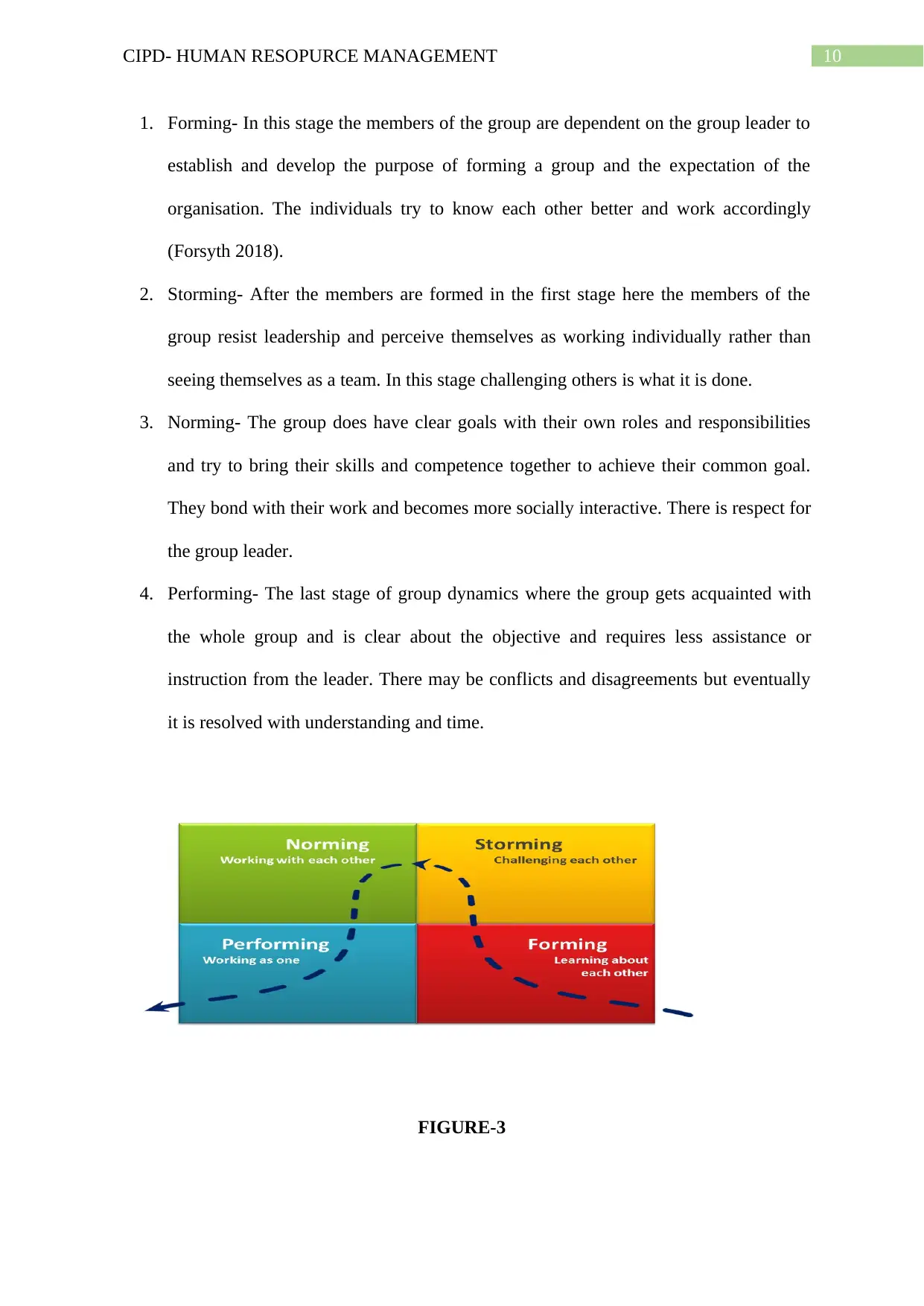
10CIPD- HUMAN RESOPURCE MANAGEMENT
1. Forming- In this stage the members of the group are dependent on the group leader to
establish and develop the purpose of forming a group and the expectation of the
organisation. The individuals try to know each other better and work accordingly
(Forsyth 2018).
2. Storming- After the members are formed in the first stage here the members of the
group resist leadership and perceive themselves as working individually rather than
seeing themselves as a team. In this stage challenging others is what it is done.
3. Norming- The group does have clear goals with their own roles and responsibilities
and try to bring their skills and competence together to achieve their common goal.
They bond with their work and becomes more socially interactive. There is respect for
the group leader.
4. Performing- The last stage of group dynamics where the group gets acquainted with
the whole group and is clear about the objective and requires less assistance or
instruction from the leader. There may be conflicts and disagreements but eventually
it is resolved with understanding and time.
FIGURE-3
1. Forming- In this stage the members of the group are dependent on the group leader to
establish and develop the purpose of forming a group and the expectation of the
organisation. The individuals try to know each other better and work accordingly
(Forsyth 2018).
2. Storming- After the members are formed in the first stage here the members of the
group resist leadership and perceive themselves as working individually rather than
seeing themselves as a team. In this stage challenging others is what it is done.
3. Norming- The group does have clear goals with their own roles and responsibilities
and try to bring their skills and competence together to achieve their common goal.
They bond with their work and becomes more socially interactive. There is respect for
the group leader.
4. Performing- The last stage of group dynamics where the group gets acquainted with
the whole group and is clear about the objective and requires less assistance or
instruction from the leader. There may be conflicts and disagreements but eventually
it is resolved with understanding and time.
FIGURE-3
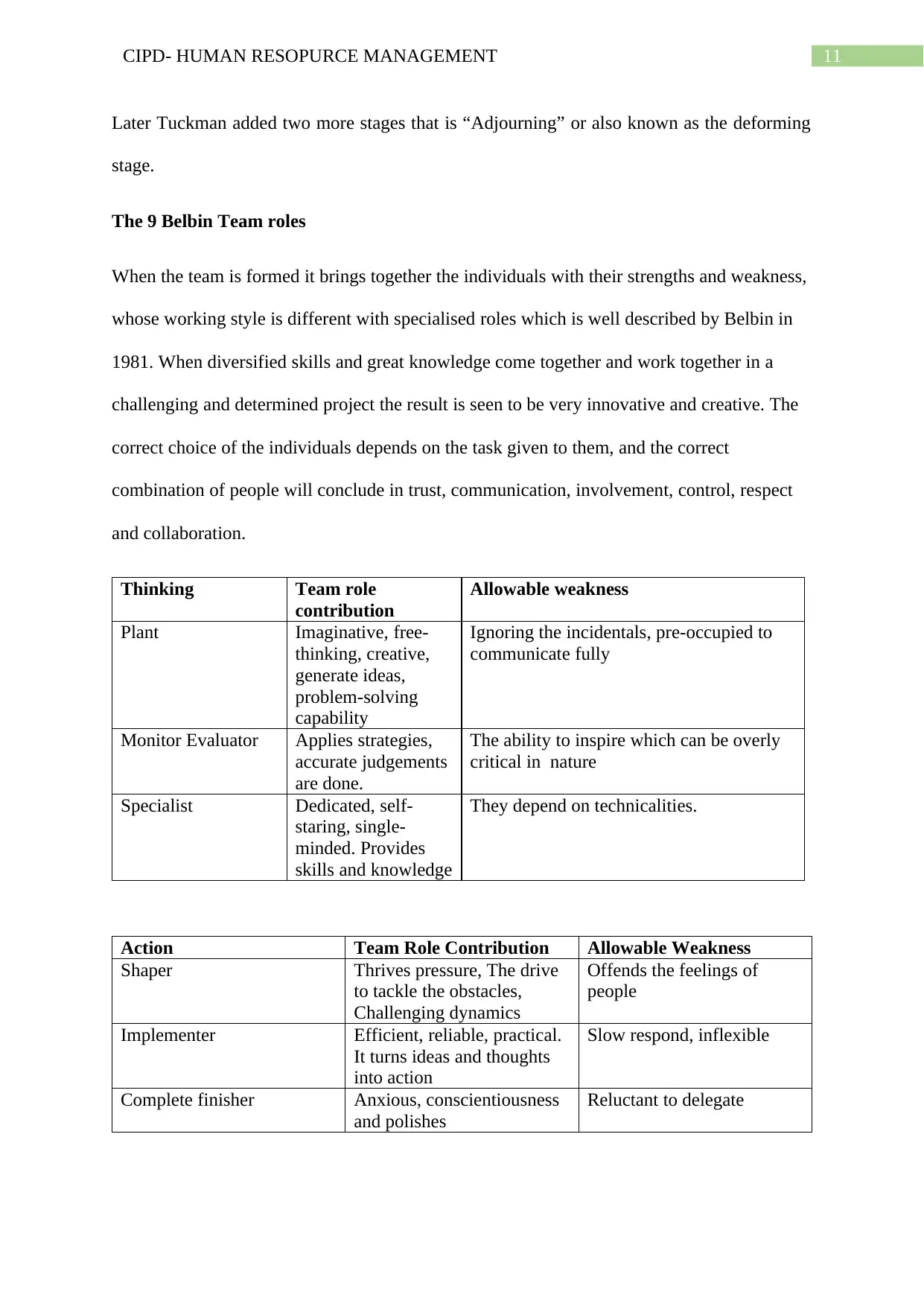
11CIPD- HUMAN RESOPURCE MANAGEMENT
Later Tuckman added two more stages that is “Adjourning” or also known as the deforming
stage.
The 9 Belbin Team roles
When the team is formed it brings together the individuals with their strengths and weakness,
whose working style is different with specialised roles which is well described by Belbin in
1981. When diversified skills and great knowledge come together and work together in a
challenging and determined project the result is seen to be very innovative and creative. The
correct choice of the individuals depends on the task given to them, and the correct
combination of people will conclude in trust, communication, involvement, control, respect
and collaboration.
Thinking Team role
contribution
Allowable weakness
Plant Imaginative, free-
thinking, creative,
generate ideas,
problem-solving
capability
Ignoring the incidentals, pre-occupied to
communicate fully
Monitor Evaluator Applies strategies,
accurate judgements
are done.
The ability to inspire which can be overly
critical in nature
Specialist Dedicated, self-
staring, single-
minded. Provides
skills and knowledge
They depend on technicalities.
Action Team Role Contribution Allowable Weakness
Shaper Thrives pressure, The drive
to tackle the obstacles,
Challenging dynamics
Offends the feelings of
people
Implementer Efficient, reliable, practical.
It turns ideas and thoughts
into action
Slow respond, inflexible
Complete finisher Anxious, conscientiousness
and polishes
Reluctant to delegate
Later Tuckman added two more stages that is “Adjourning” or also known as the deforming
stage.
The 9 Belbin Team roles
When the team is formed it brings together the individuals with their strengths and weakness,
whose working style is different with specialised roles which is well described by Belbin in
1981. When diversified skills and great knowledge come together and work together in a
challenging and determined project the result is seen to be very innovative and creative. The
correct choice of the individuals depends on the task given to them, and the correct
combination of people will conclude in trust, communication, involvement, control, respect
and collaboration.
Thinking Team role
contribution
Allowable weakness
Plant Imaginative, free-
thinking, creative,
generate ideas,
problem-solving
capability
Ignoring the incidentals, pre-occupied to
communicate fully
Monitor Evaluator Applies strategies,
accurate judgements
are done.
The ability to inspire which can be overly
critical in nature
Specialist Dedicated, self-
staring, single-
minded. Provides
skills and knowledge
They depend on technicalities.
Action Team Role Contribution Allowable Weakness
Shaper Thrives pressure, The drive
to tackle the obstacles,
Challenging dynamics
Offends the feelings of
people
Implementer Efficient, reliable, practical.
It turns ideas and thoughts
into action
Slow respond, inflexible
Complete finisher Anxious, conscientiousness
and polishes
Reluctant to delegate
⊘ This is a preview!⊘
Do you want full access?
Subscribe today to unlock all pages.

Trusted by 1+ million students worldwide
1 out of 25
Related Documents
Your All-in-One AI-Powered Toolkit for Academic Success.
+13062052269
info@desklib.com
Available 24*7 on WhatsApp / Email
![[object Object]](/_next/static/media/star-bottom.7253800d.svg)
Unlock your academic potential
Copyright © 2020–2025 A2Z Services. All Rights Reserved. Developed and managed by ZUCOL.




![5DVP: Developing Professional Practice Report - [University Name]](/_next/image/?url=https%3A%2F%2Fdesklib.com%2Fmedia%2Fimages%2Frq%2Fd1f1fed29d4c4b72b622be5f5f3b52cf.jpg&w=256&q=75)